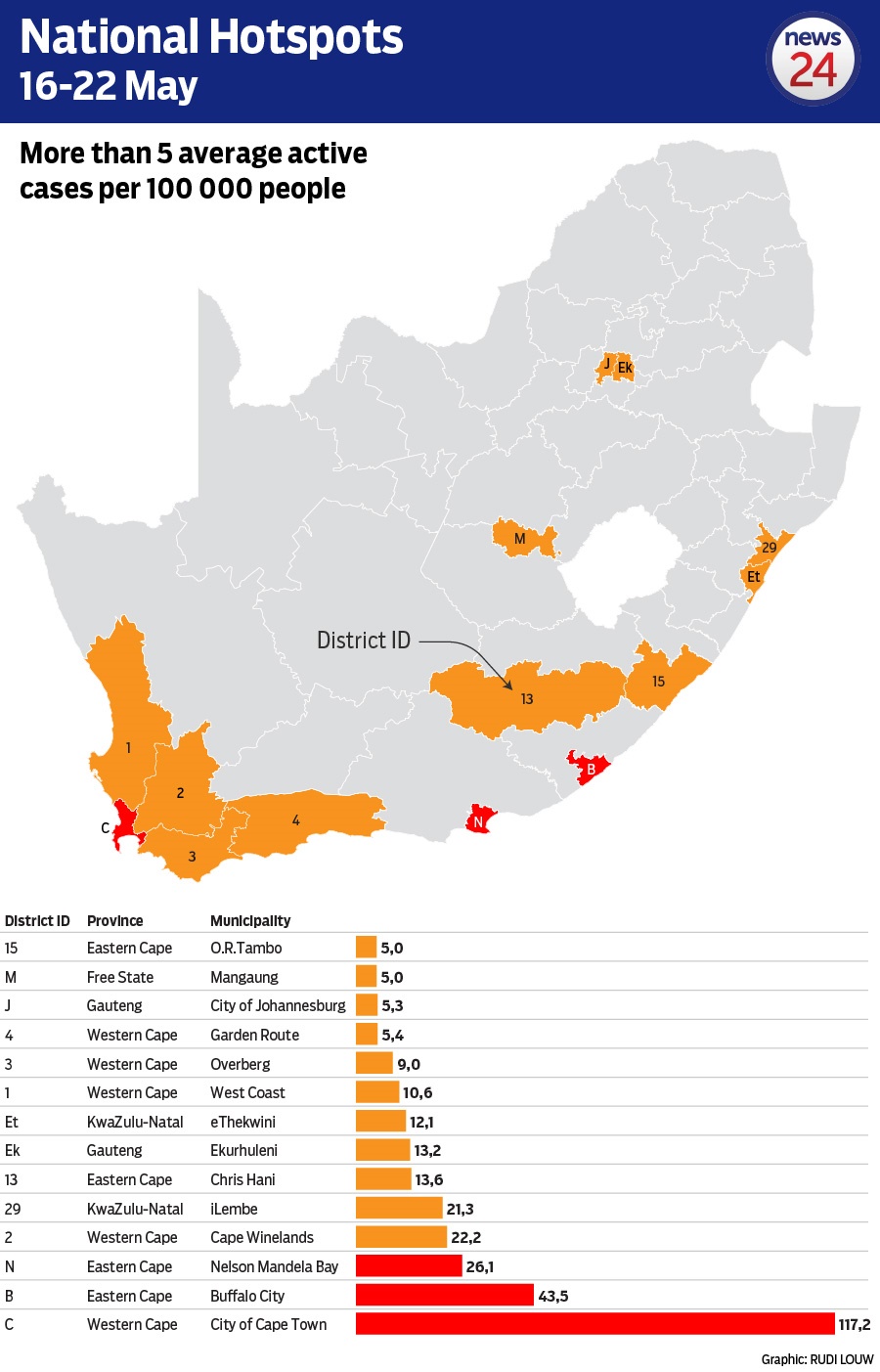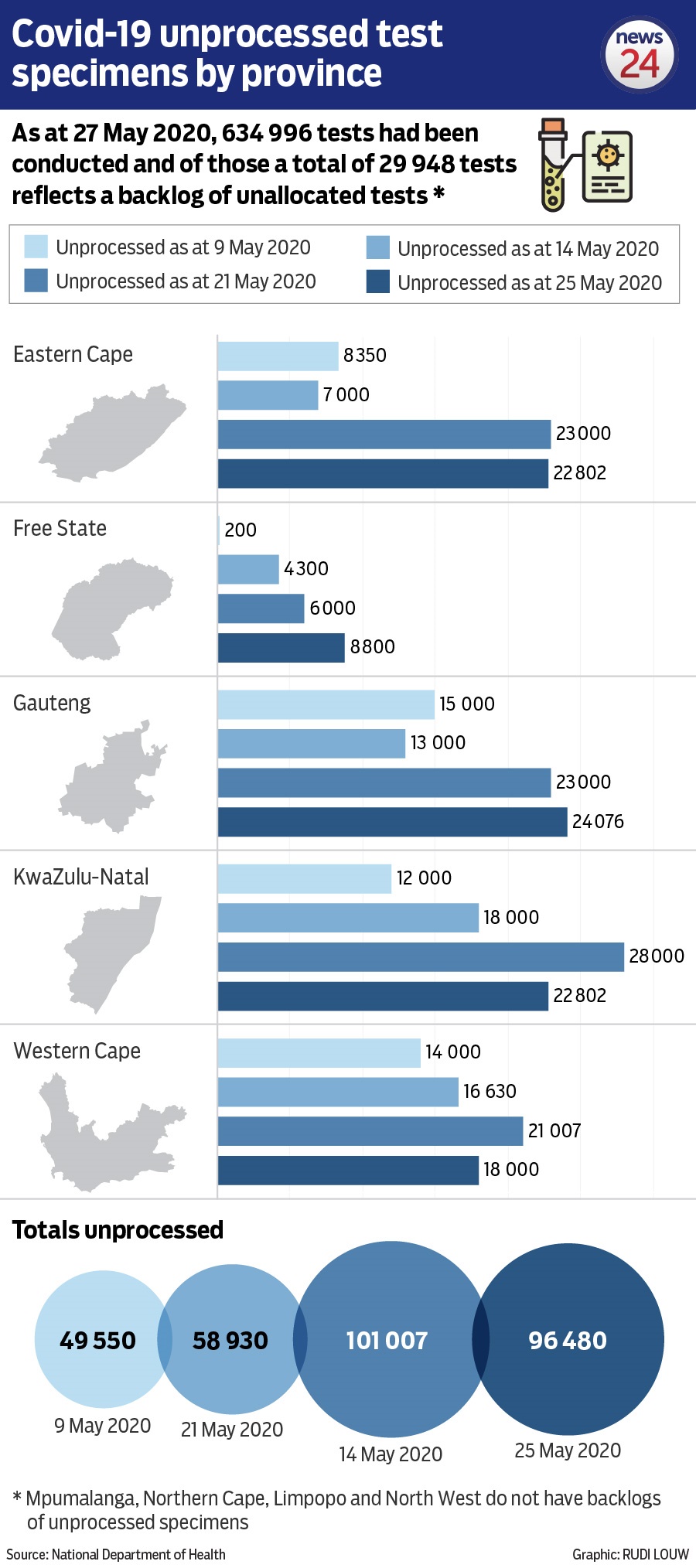


Eastern Cape Premier Oscar Mabuyane.
- It took just 79 days for the number of confirmed Covid-19 cases in the Eastern Cape to reach 5 900.
- Health minister Zweli Mkhize has expressed concern over the trajectory of the coronavirus in the province where 101 have died so far.
- The Eastern Cape outbreak is overshadowed only by its neighbour, the Western Cape – and growing at a faster rate than Gauteng.
It has been 55 days since the first Covid-19 death in the Eastern Cape was recorded on 14 April, which became only the second province in the country to reach a death toll of more than 100 people over the weekend.
With 101 deaths and 5 974 confirmed cases, of which 3 207 were active cases as of Sunday, the Eastern Cape is experiencing the second most deadly Covid-19 outbreak in South Africa so far.
This translates to around 48 active cases per 100 000 people in the Eastern Cape – nearly double the rate in Gauteng, the next closest province.
It is surpassed only by the Western Cape, its neighbour, which has recorded 31 824 cases and 774 deaths out of the country’s total 48 285 cases and 998 deaths.
READ HERE | Western Cape will need help from other provinces to fight Covid-19, says Ramaphosa
Considering the number of recoveries in the Western Cape, 17 366, this means the province is currently dealing with roughly 200 active Covid-19 cases per 100 000 people.
At first glance Gauteng and the Eastern Cape appear to be following remarkably similar trajectories.
But a closer look reveals the epidemic in the province is progressing faster – it took Gauteng 93 days to reach 5 900 cases, while the Eastern Cape took 79 days.
READ | Don’t worry if you live next to a quarantine site – Gauteng health dept
By Day 79 since the first Covid-19 case was confirmed in the province, it had 101 deaths.
In Gauteng, which stands on 93 days since its first infection, 47 deaths have been reported so far.
A comparison of the outbreaks in the two provinces over time shows just how much faster the Eastern Cape outbreak is occurring.
This graph, which compares the respective outbreaks by day since the first case was confirmed in each province, shows that around Day 53 of the Eastern Cape’s outbreak, the province showed a marked spike in cases that continued to outpace that of Gauteng.



News24 reported on Sunday that the Health Department, in a statement, said the Eastern Cape’s Covid-19 hotspots will be divided into sub-districts to better manage the fight against the pandemic through regional responses in the “vulnerable” province.
“The hotspot strategy is to facilitate a strong community-based response… Decentralisation is particularly important for rural areas to ensure they are adequately capacitated and empowered to successfully manage the epidemic locally,” the department said.
The Eastern Cape has similar numbers to Gauteng but it has recorded the second highest mortality numbers and its proximity and inter-connectedness with the Western Cape makes the province especially vulnerable.
“In addition, there is an increase in infection rates among healthcare workers both in the public and private sectors. As of 6 June, the Eastern Cape had recorded 258 Covid-19 positive healthcare workers and 14 Covid-19-related deaths,” the statement read.
While the Eastern Cape’s cumulative number of cases is near that of Gauteng’s, analysis of the reported data shows Covid-19 has been spreading there at a faster rate.



When plotted by date of confirmed cases reported, the key difference between the Eastern Cape and Gauteng is not immediately apparent, as seen in this graph.
The Western Cape has been excluded here.
READ HERE | Coronavirus: 55 schools in Western Cape report cases, 30 schools in Gauteng
Mkhize raised concern over the mortality rate in the Eastern Cape on Sunday, and a graphical representation of deaths over time for each province makes his concern clear.



Hotspots in the Eastern Cape include Nelson Mandela Bay and Buffalo City. The Health Department determines hotspots by calculating the average daily active cases per 100 000 people estimated to be living in the district or metro and if the number is above 5, the area is classified as a hotspot.



This graphic shows the areas classified as hotspots nationally as of late May – the last time the Health Department released detailed breakdowns of the national hotspots.
The data relied on to make the comparison of the Eastern Cape with Gauteng, are the daily reported figures as released by the department.
READ | Tobacco group to argue Dlamini-Zuma overstepped powers in banning sales of cigarettes
The true rate of growth for the respective epidemics may be severely impacted by the large number of tests backlogged in public laboratories which is roughly 22 000 for both the Eastern Cape and Gauteng.



The department does not release provincial testing numbers on a daily basis but the latest available data for testing per province, 24 May, shows more clear signs that the outbreak in the Eastern Cape is moving at a faster pace than in other provinces (except for the Western Cape):
By May 24, 59 094 tests had been conducted in the Eastern Cape – with a resultant 2 690 positive cases. Gauteng comparatively, had conducted 196 663 tests by the same date – and found 2 773 cases.
Stay healthy and entertained during the national lockdown. Sign up for our Lockdown Living newsletter. Sign up and manage your newsletters in the new News24 app by clicking on the Profile tab

